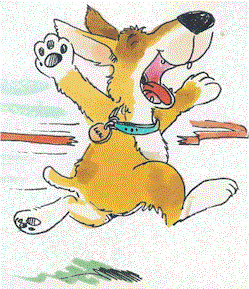Body Speak
|
|
|
|
Does your mouth say the same thing as your body?
|
|
Command |
Action |
Expectation |
|
Wait |
Point finger at dog |
Stay where it is until I give it another command (or release command), such as come, fetch, find it etc. In other words, it will be asked to do something else in the near future and should watch me closely |
|
Stay |
Palm of hand pushed towards dog |
Stay where it is until I return to its side. It can relax until I return, ignoring any verbal or physical commands I may accidentally make. It can only move when I return to its side, have praised it and then given it the release command. |
|
That’ll do |
Pat the dog while smiling to show you are pleased with it |
Dog’s release command. Exercise over. You can move now. |
 This
is a good example of how many dog owners get confused what they want their dogs to do – wait or
stay. This causes the dog to become anxious and more
likely to break these two commands, as the end of the exercise is unclear to them – when should
they move?
This
is a good example of how many dog owners get confused what they want their dogs to do – wait or
stay. This causes the dog to become anxious and more
likely to break these two commands, as the end of the exercise is unclear to them – when should
they move?
When do you use your dog’s name?
Is it to catch its attention and give you eye contact before you give the next
command? Or do you use its name to make the dog
come to you, or perhaps use the name as a warning when it has done something wrong?
It is well worth thinking about.
 Other
commands which can confuse
Other
commands which can confuse
Down is another command that often confuses dogs. It
usually means lie flat on the ground, but can also mean stop jumping up or get off the
furniture.
By having different commands for each instance (e.g. 'Flat' for lying down; 'Off' for stop jumping up, put all four paws on the floor; and 'Get Down' for get off the furniture) the dog is far more likely to understand what is expected of it. What about the command 'Right?' Is it a directional command to your dog or do you use it to tell the dog it is correct?
Be careful not to use similar sounding words as commands, especially if they sound like the dog’s name. 'Go' and 'No' sound very similar, as does the name 'Jo' or any other name ending in 'O.'
 Be
aware of the tone of your voice
Be
aware of the tone of your voice
When you give a command – keep it clear, happy and free from stress.
A classic example of this are dogs which don’t come back when called – they can hear the
anxiety and frustration in their owner’s voices and soon associate the tone with having their
lead put on. Their fun will be over and there is no
reward. By training a dog to associate the sound of a
dog whistle with treats, fun games with its owner, etc, the dog will not be affected by the
changes in its owners voice when they are worried, angry etc, and will come when called.
Men with deep voices often have difficulty giving verbal commands to their dog, especially submissive animals. These nervous dogs misinterpret the situation by associating the deep/loud command with that of being told off. To combat this situation, these men should either raise the tonal register of their voices, whisper or use body signals wherever possible instead.
 Body
talk
Body
talk
With regards body signals, your dog can easily misinterpret these – especially collies who
are very body/movement sensitive. For example,
keep your arms still and your hands clasped in front of you as you walk away from your dog in a
wait. The dog will then be more aware of the movement of
your arms when you signal it to come. Make sure you do
not turn away from your dog when giving visual signals, it won’t be able to see them clearly
and will become unsure of what you want it to do.
Dogs can also be confused by the different tones of voice and body signals of other members of your family. Your list will make it easier for everyone in the household to become consistent with the commands and signals they use – resulting in a happier, trusting and less confused dog who is more likely to do as it’s told!
Remember
Whether they are vocal commands or visual ones - be consistent.
Then your dog has a better opportunity of being consistent as well.
For more information and training tips about training dogs using kind positive methods visit Sally's Dog-Games website - http://www.dog-games.co.uk - and wander around the Training Terms section of the Main Menu.
 About
the author...
About
the author...
Sally Hopkins lives in Malvern with her
husband Sean and has competed in Agility, BFA Flyball
and Cleverdogs for many years.
Having attended the two year-long International Dog Training School run by Scallywags Canine Education Centre, Rugeley, Sally is now involved in giving seminars (both in the UK and in Europe) promoting the revolutionary stress-reducing techniques that they taught her. She is a Full Member of the Pet Dog Trainers of Europe, whose Chairman is the internationally famous Turid Rugaas from Norway.
Sally has set up her 200+page website www.dog-games.co.uk to help and educate the general public about their dog's instincts and behaviour, and to explain how positive training methods are far more effective than old-fashioned aversive methods.
|
[bottom.htm] © Copyright Agilitynet |